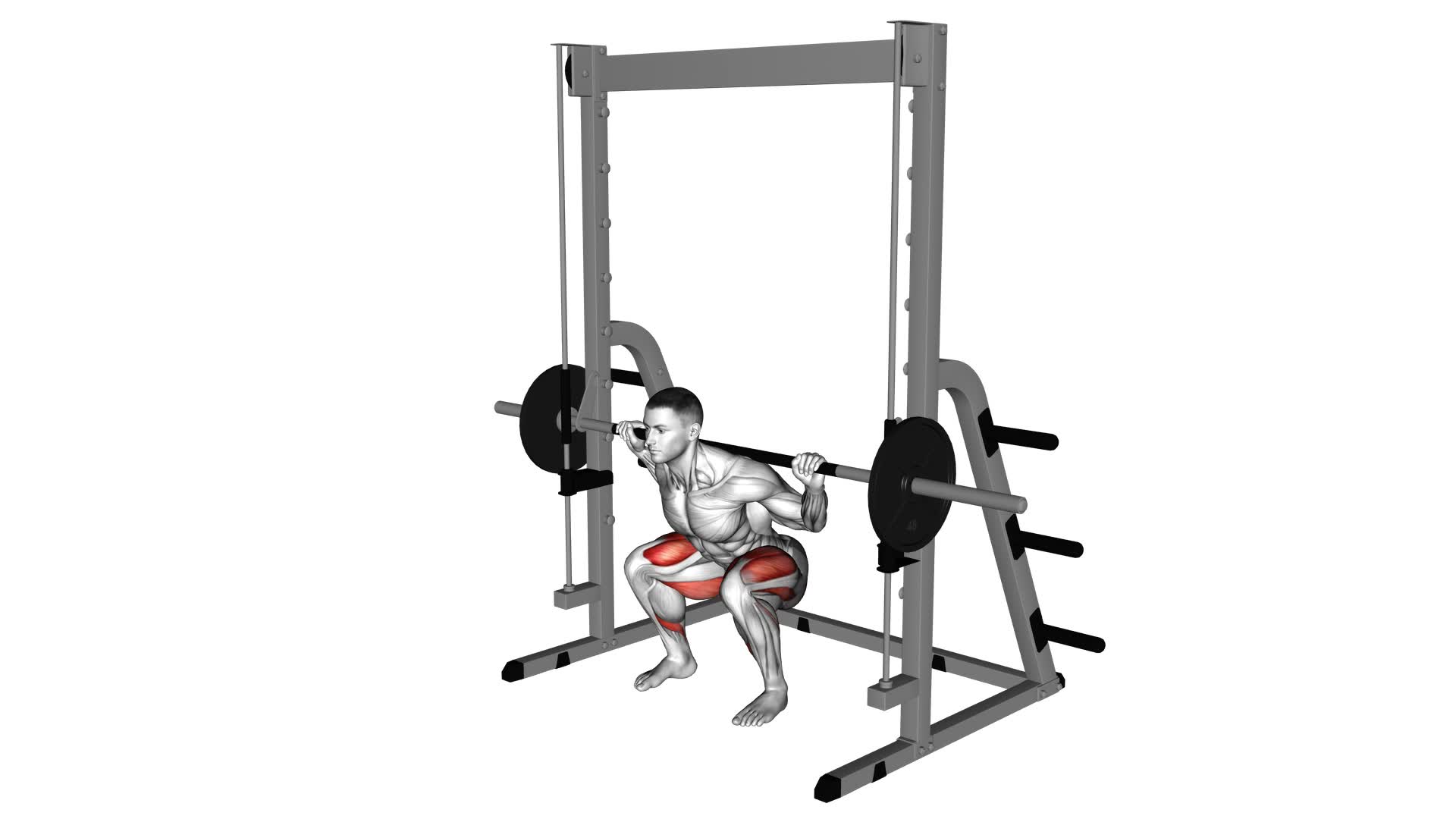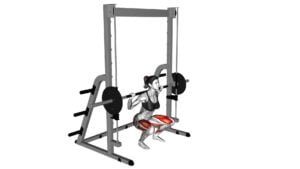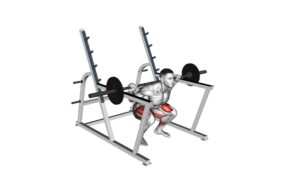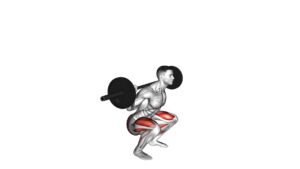Smith Low Bar Squat – Video Exercise Guide & Tips

Are you looking to improve your strength and build muscle? Look no further than the Smith Low Bar Squat.
Watch This Exercise Video
In this video exercise guide, you'll find all the tips and techniques you need to perform this exercise correctly and safely. From proper set-up and equipment to key points for proper form, we'll cover it all.
Don't miss out on this effective training method that will take your fitness to the next level.
Let's get started!
Key Takeaways
- Increased strength and stability
- Activation of multiple muscle groups simultaneously
- Emphasis on the hips and posterior chain
- Improved squatting technique
Benefits of the Smith Low Bar Squat
You can experience increased strength and stability through the Smith Low Bar Squat. This exercise is known for its ability to activate multiple muscle groups simultaneously, making it an efficient choice for building overall strength. The low bar position of the Smith machine places more emphasis on the hips and posterior chain, including the glutes, hamstrings, and lower back. By targeting these muscles, the Smith Low Bar Squat can help improve your squatting technique and increase the amount of weight you can lift.
In addition to muscle activation, the Smith Low Bar Squat also offers injury prevention benefits. The guided motion of the machine helps maintain proper form throughout the movement, reducing the risk of injury. The barbell track on the Smith machine ensures a stable and controlled squatting motion, minimizing the chances of straining your back or knees.
Proper Set-Up and Equipment
To properly set up for the Smith Low Bar Squat, it's important to ensure correct bar placement on your back. The bar should be positioned on your rear delts, just below your traps, to maintain stability and prevent injury.
Additionally, essential equipment such as a Smith machine or squat rack, a barbell, and weight plates are necessary for safety and effective execution of this exercise.
Correct Bar Placement
Ensure proper bar placement by selecting the appropriate equipment and setting it up correctly.
When it comes to the Smith Low Bar Squat, bar position is crucial for a safe and effective workout. To begin, choose a Smith machine that allows you to position the bar at the appropriate height.
The bar should be placed on the meaty part of your upper back, just below your traps. This lower bar placement helps to engage your posterior chain and promote proper form. Make sure the bar is centered evenly on your back and not leaning to one side.
When setting up the equipment, ensure that the bar is secure and stable, with no wobbling or shifting.
With the correct bar placement, you can now move on to the essential equipment for safety, such as proper footwear and supportive gear.
Essential Equipment for Safety
For safety and proper set-up of the Smith Low Bar Squat, start by ensuring that you have the essential equipment in place.
Weightlifting gear is crucial to protect yourself from injuries and maximize your performance. Firstly, invest in a good pair of weightlifting shoes. These shoes provide stability and support to your feet, enhancing your balance and technique.
Additionally, wear a weightlifting belt to provide support to your lower back and core muscles, reducing the risk of injury.
It's also essential to have a reliable barbell with appropriate weight plates that can handle the load you're lifting.
Finally, use safety equipment such as collars to secure the weights in place and prevent them from sliding off during the exercise.
Key Points for Proper Form
To ensure proper form during the Smith low bar squat, there are three key points you need to focus on.
First, foot placement is important as it provides a stable base for the movement.
Second, proper hip and knee alignment is crucial to prevent injury and maximize effectiveness.
Lastly, the barbell should be positioned correctly on your back to maintain balance and stability throughout the exercise.
Foot Placement Importance
Place your feet correctly to maintain proper form while performing the Smith Low Bar Squat. Foot position plays a crucial role in achieving optimal balance and stability during this exercise. Start by positioning your feet slightly wider than shoulder-width apart, with toes pointing slightly outward. This stance helps to activate the glutes, hamstrings, and quadriceps effectively.
Additionally, ensure that your weight is evenly distributed between both feet. This will help you maintain stability throughout the movement and prevent any excessive strain on one side of your body.
Hip and Knee Alignment
To achieve proper form in the Smith Low Bar Squat, it's crucial that you ensure proper alignment of your hips and knees. Here are some key points to keep in mind:
- Hip mobility: Before you begin your squat, make sure your hips are adequately warmed up and have good mobility. This will help you achieve proper depth and prevent any strain or discomfort.
- Knee alignment: As you descend into the squat, focus on keeping your knees in line with your toes. Avoid letting them cave inward or push too far forward, as this can put unnecessary stress on your joints.
- Maintain a neutral spine: Throughout the movement, strive to keep your spine in a neutral position. Avoid excessive rounding or arching of the back, as this can compromise your form and lead to injury.
- Proper squat depth: Find a depth that allows you to maintain good form while challenging your muscles. Aim to go as low as you can without compromising your hip and knee alignment.
Barbell Position on Back
Position the barbell on your back to ensure proper form during the Smith Low Bar Squat. The correct placement of the barbell is crucial for maintaining balance and stability throughout the exercise.
To start, grip the barbell with your hands slightly wider than shoulder-width apart. This grip allows for better control and stability during the movement.
Now, focus on your shoulder mobility. Make sure your shoulders are flexible enough to comfortably hold the barbell on your upper back. If you have limited shoulder mobility, you can use a wider grip or utilize a pad to cushion the barbell.
Common Mistakes to Avoid
Avoid leaning forward excessively during the Smith Low Bar Squat, as it can compromise your form and increase the risk of injury. Maintaining proper technique is crucial to getting the most out of this exercise while minimizing the chance of harm.
Here are some common mistakes to avoid when performing the Smith Low Bar Squat:
- Rounding your back: Keep your back flat and engage your core throughout the movement. Rounding your back puts unnecessary strain on your spine and can lead to injury.
- Allowing your knees to cave inwards: Make sure to push your knees outwards as you squat down. Allowing them to collapse inward puts stress on your knee joints and can lead to pain or injury.
- Lifting your heels: Keep your feet flat on the ground and distribute the weight evenly. Lifting your heels shifts the load to the front of your feet, compromising balance and stability.
- Going too deep: While it's important to achieve proper depth in the squat, going too low can strain your knees and lower back. Aim to squat until your thighs are parallel to the ground.
Variation and Progression Exercises
Are you ready to take your Smith Low Bar Squat to the next level with some variation and progression exercises?
Adding variation and progression techniques to your workout routine not only helps to keep things interesting but also helps to challenge your muscles in new ways.
One effective progression technique is increasing the weight you lift gradually over time. As you become stronger, you can add more weight to the barbell to continue challenging your muscles and promoting muscle growth.
Another progression exercise is the pause squat. This exercise involves pausing for a few seconds at the bottom of the squat position before returning to the starting position. This increases the time under tension and activates your muscles even more.
Additionally, you can try incorporating tempo squats, which involve controlling the lowering and raising phases of the squat to further engage your muscles.
By incorporating these progression techniques and variations into your Smith Low Bar Squat routine, you can continue to challenge your muscles and improve your strength and stability.
Now, let's move on to the next section for some safety tips to ensure effective training.
Safety Tips for Effective Training
To ensure effective training, it's important to prioritize safety when performing the Smith Low Bar Squat and incorporating variation and progression exercises. Here are some safety tips to keep in mind:
- Proper Breathing Techniques: It's crucial to practice proper breathing techniques during the Smith Low Bar Squat. Inhale deeply before descending into the squat and exhale forcefully as you push back up. This helps stabilize your core and maintain proper form.
- Warm Up Exercises: Before diving into the Smith Low Bar Squat, it's essential to warm up your body. Perform dynamic stretches and movements that target the muscles you'll be using during the exercise. This helps increase blood flow to the muscles, improves flexibility, and reduces the risk of injury.
- Maintain Proper Form: Focus on maintaining proper form throughout the exercise. Keep your back straight, chest up, and core engaged. Avoid rounding your shoulders or arching your back. A good way to ensure proper form is by performing the exercise in front of a mirror or with a trainer's guidance.
- Use Appropriate Weight: Start with lighter weights and gradually increase the load as your strength and technique improve. Using weights that are too heavy can compromise your form and lead to injuries. Always listen to your body and adjust the weight accordingly.
Frequently Asked Questions
Can the Smith Low Bar Squat Help Improve My Overall Lower Body Strength?
The Smith Low Bar Squat is a great exercise that can help improve your overall lower body strength. By incorporating this exercise into your routine, you can target your glutes, hamstrings, and quads, resulting in increased strength and muscle development.
Additionally, this exercise can provide benefits for individuals with knee and back problems, as it places less stress on these areas compared to traditional squats. Incorporating the Smith Low Bar Squat into your workout regimen can yield significant improvements in lower body strength.
How Often Should I Incorporate the Smith Low Bar Squat Into My Workout Routine?
To determine how often you should incorporate the Smith low bar squat into your workout routine, consider your fitness goals and overall lower body strength.
The Smith low bar squat can indeed help improve your lower body strength. However, the frequency of incorporating this exercise will depend on various factors such as your current fitness level, recovery ability, and other exercises in your routine.
It's recommended to consult with a fitness professional to create a personalized workout plan that best suits your needs.
Are There Any Specific Muscle Groups That the Smith Low Bar Squat Targets?
The Smith low bar squat is a great exercise that targets multiple muscle groups. It primarily works your quadriceps, hamstrings, and glutes. By incorporating this exercise into your workout routine, you can benefit from increased leg strength and muscle development.
To ensure proper form and technique, remember to position the barbell on your back, keep your chest up, and lower your hips down until your thighs are parallel to the ground.
Can the Smith Low Bar Squat Be Beneficial for Individuals With Knee or Back Problems?
The Smith low bar squat can be beneficial for individuals with knee or back problems. When performed with proper form and technique, it can help strengthen the muscles surrounding the knees and lower back, providing support and stability.
Are There Any Modifications or Alternative Exercises for Those Who Don't Have Access to a Smith Machine?
If you don't have access to a Smith machine, there are still modifications and alternative exercises you can do.
For the low bar squat, you can try using a regular barbell and focus on maintaining good form and technique.
You can also try other lower body exercises like goblet squats, lunges, or step-ups to target similar muscle groups.
Remember to start with lighter weights and gradually increase as you feel more comfortable and confident.
Conclusion
In conclusion, the Smith Low Bar Squat is a highly beneficial exercise for building lower body strength.
By ensuring proper set-up and equipment, maintaining proper form, and avoiding common mistakes, you can maximize the effectiveness of this exercise.
Additionally, incorporating variation and progression exercises can help you continue challenging your muscles and making progress.
Lastly, always prioritize safety during your training sessions to avoid injuries and achieve optimal results.

Author
Years ago, the spark of my life’s passion ignited in my mind the moment I stepped into the local gym for the first time. The inaugural bead of perspiration, the initial endeavor, the very first surge of endorphins, and a sense of pride that washed over me post-workout marked the beginning of my deep-seated interest in strength sports, fitness, and sports nutrition. This very curiosity blossomed rapidly into a profound fascination, propelling me to earn a Master’s degree in Physical Education from the Academy of Physical Education in Krakow, followed by a Sports Manager diploma from the Jagiellonian University. My journey of growth led me to gain more specialized qualifications, such as being a certified personal trainer with a focus on sports dietetics, a lifeguard, and an instructor for wellness and corrective gymnastics. Theoretical knowledge paired seamlessly with practical experience, reinforcing my belief that the transformation of individuals under my guidance was also a reflection of my personal growth. This belief holds true even today. Each day, I strive to push the boundaries and explore new realms. These realms gently elevate me to greater heights. The unique combination of passion for my field and the continuous quest for growth fuels my drive to break new ground.







